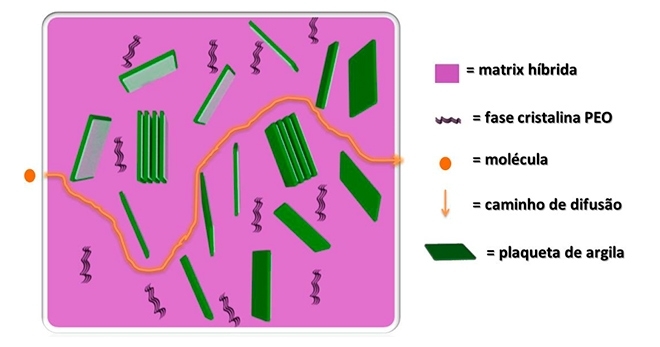

Brazilian researchers combined clay and polymer on the nanometric scale to create a structure that can be used to load and release drugs gradually (image: Eduardo Molina)
Brazilian researchers combined clay and polymer on the nanometric scale to create a structure that can be used to load and release drugs gradually.
Brazilian researchers combined clay and polymer on the nanometric scale to create a structure that can be used to load and release drugs gradually.

Brazilian researchers combined clay and polymer on the nanometric scale to create a structure that can be used to load and release drugs gradually (image: Eduardo Molina)
By Elton Alisson | Agência FAPESP – Already used in agriculture and cosmetics, clay minerals can also be applied in medications such as anti-inflammatory and chemotherapy agents to enhance their effects.
The new material was developed under the aegis of the National Institute of Science and Technology in Advanced Eco-Efficient Cement-Based Technologies (INCT-AECem), one of the INCTs funded by FAPESP in partnership with the National Council for Scientific and Technological Development (CNPq) in São Paulo State. The process by which the structure was obtained is described in an article published in Applied Materials & Interfaces, a journal of the American Chemical Society.
“We combined a commercial clay called sodium montmorillonite with a nanometer-scale polymer gel to obtain a material that ensures the gradual release of a drug at optimal doses and speeds, maintaining the ideal concentration in the bloodstream,” said Eduardo Molina, a professor at UNIFRAN and a coauthor of the study. A nanometer is a billionth of a meter.
The researchers mixed sodium montmorillonite with polyethylene oxide (PEO), a flexible and transparent material that acts as a hydrogel. Consisting of a rigid three-dimensional network, it is capable of absorbing large amounts of water in its interstices without dissolving and is considered an excellent material for controlled drug release.
However, the hydrogel alone allows very fast drug release. In addition, it can permit what is known as “burst release”, in which a high dose is initially released and the drug is then delivered at a steady rate. “The hydrogel based only on PEO doesn’t ensure slow and controlled drug release,” Molina told Agência FAPESP.
Given clay’s well-known waterproofing properties, the researchers decided to combine it with the hydrogel to see if the material would act as a barrier to permit fine control of drug delivery.
To test this hypothesis, sodium montmorillonite was blended at different levels with a hybrid organic-inorganic hydrogel called siloxane-polyether or ureasil by means of a process known as sol-gel.
This method of material preparation is based on a series of chemical reactions in which a liquid with nanoparticles in suspension (a “sol” or a colloidal solution) is gradually transformed into a network of polymers (a “gel” or liquid particles dispersed in a solid medium).
The combination of clay and polymer hydrogel resulted in a nanocomposite to which was added diclofenac sodium, a nonsteroidal anti-inflammatory drug that can be taken orally or by injection and is used to reduce swelling and treat pain in patients with arthritis, rheumatism, gout or injured muscles, for example, as well as after surgery.
Analysis of the nanocomposite structure by different characterization techniques showed that the polymer hydrogel could be clearly distinguished from the clay and drug in the materials.
Performance testing to evaluate diclofenac release in the laboratory using recipients that simulate biological conditions showed that the clay was essential to control drug release. Adjustment of the percentage of clay used in preparing the nanocomposite prevented burst release of the drug and assured continuous slow delivery at a predictable rate.
“We succeeded in obtaining a drug release diffusion barrier, which is a key effect in controlling the amount of a drug released over time,” Molina said.
Nanometric lamellae
The researchers found that depending on the amount of sodium montmorillonite included in the hydrogel, the clay assumed the form of nanometric lamellae (platelike tissues) uniformly dispersed in the material, acting as a physical barrier that prevented the molecules of water and drug from passing through the channels in the hydrogel.
“The clay lamellae formed a maze inside the material, delaying motion and imposing a certain pace on water absorption and diclofenac release,” Molina said.
In the researchers’ opinion, the nanocomposite could be used to coat pills, for example, and in a sustained drug release system for the prolonged treatment of arthritis, sprains, migraine and postsurgical pain, among other uses.
The Applied Materials & Interfaces article “Highly controlled diffusion drug release from ureasil–poly(ethylene oxide)–Na+–montmorillonite hybrid hydrogel nanocomposites” (doi: 10.1021/acsami.8b04559) by Celso R. N. Jesus, Eduardo F. Molina, Sandra H. Pulcinelli and Celso V. Santilli can be retrieved from pubs.acs.org/doi/10.1021/acsami.8b04559.
Republish
The Agency FAPESP licenses news via Creative Commons (CC-BY-NC-ND) so that they can be republished free of charge and in a simple way by other digital or printed vehicles. Agência FAPESP must be credited as the source of the content being republished and the name of the reporter (if any) must be attributed. Using the HMTL button below allows compliance with these rules, detailed in Digital Republishing Policy FAPESP.





